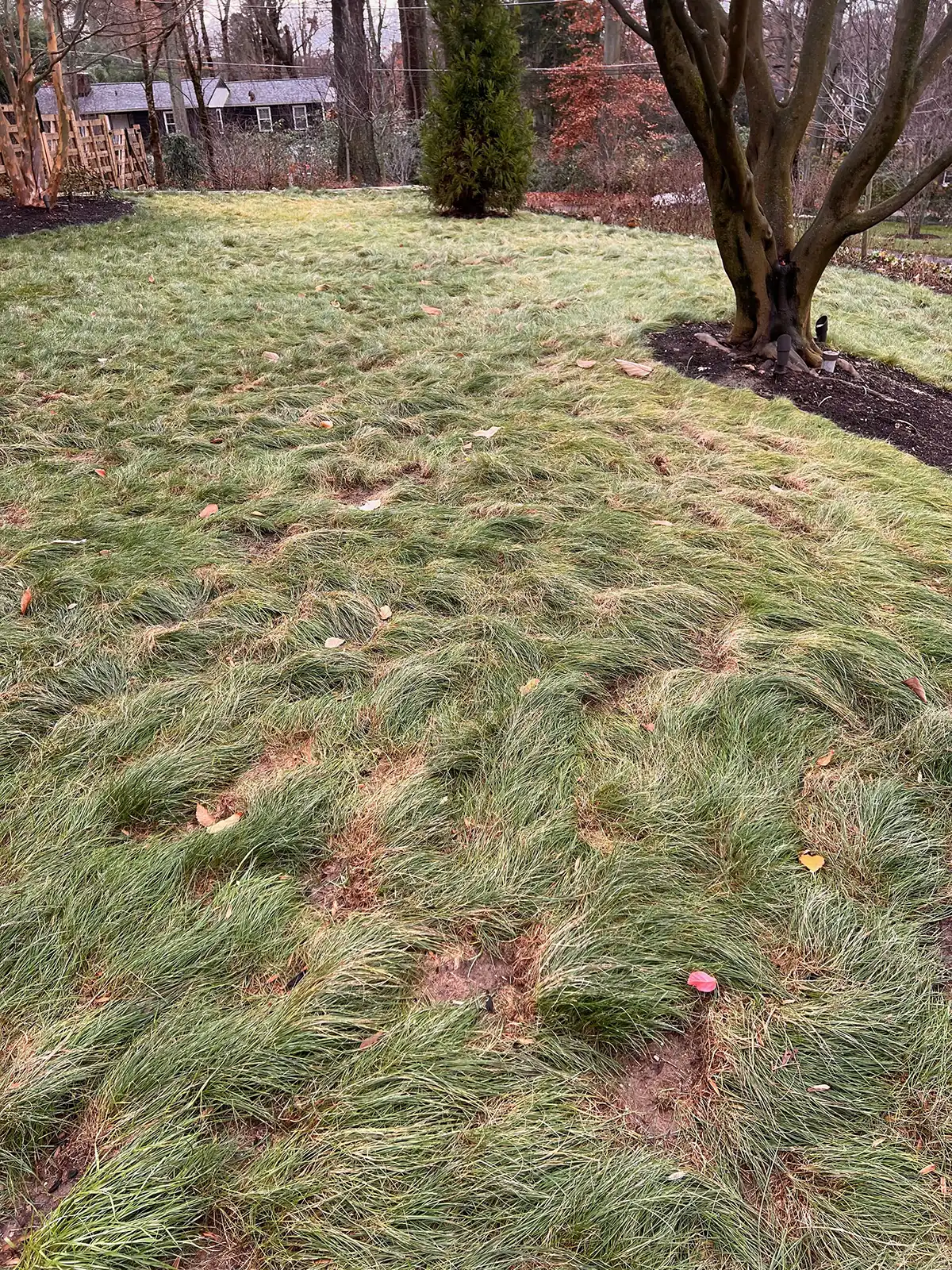Keeping your lawn perfectly manicured like a professional landscape maintenance company isn’t exactly rocket science–but it’s still a craft like any other, requiring ample knowledge and experience to master. While homeowners uninterested in the eternal quest for a perfect lawn can get by without reading a lick of this, those looking to achieve pro-quality results on their own will find the technical, practical and horticultural knowledge contained in this blog essential. Afterward, you’ll know everything necessary to stripe a lawn and cut a perfect edge with your string trimmer, as well as what height to cut your lawn at, whether or not to bag grass clippings and more. Soon enough, you may find yourself giving the landscapers on your block a run for their money. Just make sure not to tell them who gave up all the insider secrets when you do…
Table Of Contents:
Part 1: The Prerequisites: Must-Have Lawn Care Equipment & How To Maintain It
- Must-Have Lawn Maintenance Tools
- How To Shop For Lawn Care Equipment
- A Word On Battery-Powered Lawn Care Equipment
- Mower Maintenance & Sharpening Blades
Part II: Best Practices: Mowing Height, Frequency, Bagging & Safety
- Safety Precautions For Lawn Care
- Ideal Mowing Height
- Ideal Mowing Frequency
- Grass Clippings: To Bag Or Not To Bag?
Part III: Lawn Maintenance Technique: Striping And More
- Lawn Striping And Patterns 101
- Professional Lawn Edging & String Trimming Tips:
- Conclusion
Part 1: The Prerequisites: Must-Have Lawn Care Equipment & How To Maintain It
While not as fun as the mowing itself (…mowing is fun, right?), getting to know your equipment and how to use it is key to achieving the results you’re after. No matter how talented you are, with the wrong machines, settings and gear, you’ll end up working twice as hard for the same–or worse–results. So take what follows into consideration–you may find it makes a bigger difference than you think.
Must-Have Lawn Maintenance Equipment:
There are three fundamental pieces of equipment no lawn mowing professional leaves the shop without: a mower, a string trimmer (which you may know as a weed wacker or weed eater) and a leaf blower (backpack versions mostly, but handhelds are used as well). While the mower and string trimmer are essential, unless you’ve got a lot of property or a mile-long driveway to clean up after each cut, you can probably do without the leaf blower. They’re a huge convenience and an essential time-saver when doing large volumes of work, but smaller properties will find a trusty old broom just as capable, even if it’s not the fastest way to get the job done.
You may have also seen landscapers or homeowners utilizing dedicated “edgers,” with metal blades designed to create new borders along sidewalks, driveways and garden beds. Unlike string trimmers, these dedicated edgers actually cut into the soil and roots, establishing the well-defined edge you maintain with the weedwacker each week. So while not technically a tool for weekly maintenance, edgers are so easily confused with string trimmers that we felt it necessary to mention them here.

How To Shop For Lawn Care Equipment:
If you don’t already have everything you need to cut grass like a pro, a trip to your local home and garden or hardware store is in order. There, you’ll find a wide array of different mowers, blowers and string trimmers–all with different capabilities and price tags. Below we’ll go through the various options and make some suggestions for you based on your specific needs.
Importantly, you should know that higher-end landscaping tools do not necessarily produce better results than bottom-shelf, low-budget options; they’re just more comfortable and efficient. So don’t feel like your quest for the perfect lawn will be thwarted just because you can’t afford the newest, most expensive gear–if your equipment runs and cuts grass, you’ll be fine.
Regarding mower types, you’ll have three main options to choose from: ride-on mowers (including “zero-turn” models), push mowers and self-propelled, walk-behind mowers. For properties a ¼ acre or less in size, a standard push mower or self-propelled walk-behind with a cutting width (aka deck size) of 18-36” will do the trick. But properties any larger will be so physically demanding and time-consuming to cut with a push mower that, unless you’re some kind of masochist or superhuman athlete, you almost have no choice but to go with a ride-on model.
Though riding mowers will be more expensive (often between $1-5k), and won’t fit into all the same spots, their larger cutting width (up to 61”) and seated operation allows you to mow a large area twice as fast without over-exerting yourself or spending the entire day on your lawn.
Though not necessary for every homeowner, if you do decide to spring for a leaf blower, the hardest decision will be whether to go with a backpack or handheld model. If you’ve got a ton of hard surfaces to blow off after mowing, or do your own leaf clean-ups each spring and fall, a backpack blower will save you lots of time and energy. But most homeowners will find lightweight, handheld blowers perfectly capable of meeting their needs and a lot easier on the back and shoulders. So unless you really need the power of a backpack blower to push heavy piles of wet leaves or blow off 1,000 sq ft of pavement after each mow, you’ll probably find a handheld blower more convenient and better-suited for your purposes.

“Importantly, you should know that higher-end landscaping tools do not necessarily produce better results than bottom-shelf, low-budget options; they’re just more comfortable and efficient.”
Regarding string trimmers, all of them will handle an average-sized lawn without issue, but larger and more powerful models will perform better in thicker grass and under heavier workloads. So, assuming they aren’t too heavy or tall for you to maneuver easily, spending a little bit more on a solid, full-sized string trimmer is probably in your best interest. Other styles will do the trick too, but a comfortable tool you’ll actually want to go out and use may be worth spending the extra cash on in this case.
A Word On Battery-Powered Lawn Care Equipment:
Battery-powered landscaping tools by brands like Husqvarna, Ryobi and Greenworks have come a long way in recent years, with increased power and efficiency finally bringing them to the point of rivaling traditional gas-powered machinery. While battery-powered landscaping equipment can be more expensive up front, the investment saves you from paying ongoing fuel costs and greatly reduces the need for future maintenance and repair. So whether it’s convenience, finances or the fact that battery-powered equipment is simply much better for the environment than its gas-powered equivalents, we think it’s a smart decision and hope to see more homeowners make the switch moving forward.
Mower Maintenance & Sharpening Blades:
Most homeowners–including many reading right now–will skim through or skip this part entirely. Just like changing the oil on a car, maintaining a mower can be a chore that many would rather ignore. For that reason, we’ve made this section short and to the point, in hopes that at least someone will get something out of it. For the rare souls who would like to learn about maintaining their equipment thoroughly and with due diligence, we suggest you check out this more comprehensive article about lawn care equipment maintenance. And if you’re really brave, read the dreaded owner’s manuals too–they’re there for a reason.
- Check Oil Levels Regularly! Running on empty is a recipe for engine damage.
- Don’t Let Grass Cake Up Below The Mower Deck! It can lead to a reduction in work quality, performance and the overall lifespan of your mower.
- Clean Or Replace The Air Filter Each Season! This prevents dirt and grime from clogging the engine.
- Sharpen Your Blades!! While blades left to dull over time will still cut grass, they’ll also pull and tear it during the process, leaving your lawn stressed out and uneven in spots. Since it’s only necessary to sharpen mower blades once or twice a season (about every 20-25 hours of use time), doing so is something we consider an essential part of high-quality lawn care.

Luckily, sharpening mower blades yourself with a grinder or file isn’t rocket science, and if you’re not up to task, any local hardware or landscape supply store should be able to help for a nominal fee. Just be careful when you do it! Failing to use gloves and glasses or remove the spark plug before putting your hands below the mower deck can result in some really gruesome injuries.
Part II: Best Practices: Mowing Height, Frequency, Bagging & Safety
Now that you’ve got all the equipment you need, you’re ready to learn some of the best practices we (and other landscapers) follow to achieve the pro-quality results you’re after. This will help you make decisions like whether or not to bag clippings and how high to set the blades, plus explain some best practices for staying safe while mowing the lawn. Afterward, we’ll get right into the skill and technique section, so you can begin putting everything into practice and enjoy the results of your hard work!

Safety Precautions For Lawn Care:
Not to rain on your mowing parade, but as professional landscapers, we know from experience how serious accidents on the job can be when people don’t take the proper precautions. In fact, recent evidence even shows that lawn mowers kill more Americans annually than bears, sharks, alligators, snakes and spiders combined! And an additional 35,000 people also visit the emergency room for injuries from lawn care equipment each year, with all sorts of ailments we can only imagine. So just take our word for it and follow the simple precautions below. It’s better than paying medical bills and spending your summer recovering from an injury, at least.
- Wear Safety Glasses And Ear Protection: Rocks and other objects sent flying by a mower or string trimmer can easily take your eye out. And if you’ve ever had to repeat yourself to a landscaper or construction worker ten times from two feet away, you’ll understand what the hearing protection is for, too.
- Clear The Yard Before Mowing: The first thing we do before mowing is find and remove any debris or obstacles in the yard, like fallen branches or dog toys. Running those objects over with a mower can dent or damage your blades and send dangerous flying objects in all directions. So take a second to check the yard before getting started! Fido will appreciate it.
- Identify Nearby Kids And Pets: With all the loud equipment and ear plugs, it’s easy for someone or their dog to sneak up behind you unnoticed. To ensure that doesn’t happen, survey your surroundings before mowing. If there are any kids or pets around, make sure they’re at a safe distance and know not to come closer while you work.
Ideal Mowing Height:
You’ve probably noticed your mower can be adjusted to cut grass at various heights, but might not know where to set it and why. If so, you’re not alone; millions of homeowners every year cut their grass as low as possible without thinking twice about it. But many of those same people also watch their grass turn brown each summer and scratch their heads wondering why. To better understand, let’s see what our resident turf care expert Nick Green has to say about it:
“Turf Type Tall Fescue, our preferred turf variety here in southeastern Pennsylvania, should be mowed at a height of 3-4″. While some people prefer a shorter mow, mowing at this proper height maximizes leaf surface area for photosynthesis and helps protect against drought stress.”
Warm weather varieties though (figure out which variety of grass you have here!), can be cut between 2-3 inches without issue. Any lower for either variety and you’ll start to hamper grass growth, which leads to thin coverage and inconsistent coloring. So if you want to keep your grass as healthy as possible, stop cutting it too short! It may save you from having to mow as frequently, but if it’s quality you’re after–that’s not going to help.
There is also a more exact guideline you can use to figure out where to set the mowing height: the “⅓ Rule.” This states that you should never remove more than ⅓ of blade height in one mowing. So if you want to be very precise, simply measure the grass height and set your mower to cut off no more than ⅓ of it. Most likely it will be the same level week after week, so you should only need to adjust once or twice, if at all.
Ideal Mowing Frequency:
If a customer has not requested a special schedule or extra cuts, we generally stick to one mowing visit per week, which tends to do the trick at the height we cut here in southeast Pennsylvania (3-4”). But during the spring and fall, when optimal conditions cause grass to grow faster, we sometimes switch to twice-weekly mowing to keep the lawn from getting too high between visits. This is all personal preference, as excessive mowing will not damage your grass and neither will letting it get longer than average. But once a week unless it’s growing super fast is the standard and you can’t go wrong following that.
Grass Clippings: To Bag Or Not To Bag?
If you’re cutting grass at Lambeau Field, it’s essential you bag clippings in order to keep the star quarterback from ending their season on an unfortunate slip. But since you wouldn’t be reading this if you were already a top-notch turf technician working for the NFL, that’s not super relevant. For you and your residential lawn, the answer simply depends on whether or not your grass is thick or wet enough to clump up on the lawn. If so, failing to bag or blow it off afterward can result in an unhealthy build up of thatch and unsightly discoloration in spots. If not, letting the nitrogen-rich clippings filter to the soil, where they can act like a “green manure” fertilizing your lawn and promoting healthier growth, is best.
Quick Tip: If you do decide to bag, grass clippings are a wonderful green material to add into your compost pile. Doing so saves you the trouble of having to dispose of clippings and ensures you’ll have plenty of nutrient-rich soil to fill your garden with each spring.
Part III: Lawn Maintenance Technique: Striping And More
They say it takes around 10,000 hours to master something. In our experience, maintaining a beautiful lawn is not quite so hard. New employees often learn the basics in a couple of weeks and master the craft in a season or two. Of course, they’re getting forty hours of practice each week with expert supervisors at their heels, but with some focused effort and a little experience under your belt, the same level of competency is well within your grasp.

Below we’ve listed some of the pro techniques you’ll need to know in order to do the job right, like how to create checkerboard patterns and use a string trimmer to edge. If you’ve paid attention to the equipment talk and best practices above, the following bits are all you have left to learn before getting to work!
Lawn Striping And Patterns 101:
Patterns cut into a lawn via a process known as “striping” are probably the most desirable and distinguishable feature of professional lawn care. Though it may seem complicated, the effect is actually very straightforward, created simply by attaching an inexpensive “striping kit,” to the back of your mower. These kits, also easy to make yourself DIY style, consist of a roller or broom designed to weigh grass down in the direction you’re mowing. Since light hits grass differently depending on which direction it lies, the alternating rows become easily distinguishable and visible patterns emerge.
To start a standard pattern, like alternating rows or a checkerboard, you’ll want to first begin by making a few passes around the perimeter of your lawn. This provides space for you to turn around at the end of each pass without messing up your lines. Next, line yourself up at the start and begin to cut, taking care to stay as straight as possible and overlap your tracks by the same amount each time, which keeps the rows at uniform widths. If you’re not the best at doing that, consider setting up a string line between two stakes as a guide for the first couple passes, then again every so often to check you haven’t begun to waver. Once you’ve established the pattern the first time, you can just retrace it every week, so putting in some extra effort to get it right the first time is a pretty good idea.

Luckily, the two most popular patterns–alternating rows and checkerboards–are very simple. The former is actually created naturally by cutting up and down like normal with a striping kit attached (sometimes, even without the striping kit you will see the lines appear over time). And the latter is created simply by making a second cut perpendicular to the first, which creates the criss-cross pattern reminiscent of a checkerboard. This takes twice the time, but provides a very formal look that many find worth the extra effort. In both cases, make sure to make some passes around the perimeter before you finish as well, just to leave it with a nice, even border after all is said and done.
Anything more complicated, like you might see in sports stadiums on TV, will require some artistic skills that we cannot teach here. But don’t hesitate to experiment, scroll through Pinterest or Youtube to get some ideas, or try something that seems out of your league. You may find you have more of an artistic eye than you realize.
How to Mow a Checkerboard Pattern: Big League Lawns
Professional Lawn Edging & String Trimming Tips:
No good landscape professional mows a property without also edging the perimeter before they leave. Doing so frames lawn areas, providing a uniform border and accentuating the juxtaposition of grass, garden and hardscape features on your landscape. It’s a big part of why lawns cared for by professionals always look so neat and well-manicured. And as such, it’s essential to add it to your repertoire, too.
Fortunately, it’s not rocket science. All we do to transform a string-trimmer into an edging machine is flip it over and hold it upside down (see image below for clarification), which causes the head to spin and cut vertically (parallel to the blades of grass) instead of horizontally. This allows you to trim the sides without taking anything off the top (the mower’s job!), thereby keeping your grass in line with the lawn’s perimeter and preventing it from spilling over onto your hardscapes and garden beds.
Once you’ve got the string trimmer held correctly, all you’ll do is run it vertically along the perimeter after each cut to clean up the edge line. Since you’re simply retracing the original edge each week–not designing or establishing a new one–it should only take a couple minutes to complete once you get the hang of it.
If we’re being honest though, getting the hang of it is pretty damn hard. Likely, your first few attempts will result in wavy, uneven lines and lots of “scalping” or “burning” of the grass (aka, dropping the string trimmer head low enough to remove all the grass in a spot). Both issues are simply a result of not yet having the experience to keep control of the machine though, so don’t be discouraged; in time, you’ll get there too.
And guess what? Grass, like hair, grows back. So however bad you mess up, by the following week you’ll get a chance to fix it. And in the end, even a bad edging job looks much nicer than none at all, meaning you’re the only one who will notice the little mistakes or inconsistencies. Everyone else will just comment on how much better the lawn looks since you started edging it!
The only other “tip” we have to share when it comes to edging a lawn with a string trimmer is to walk backwards while you go. For whatever reason (maybe something to do with peripheral vision??), it’s easier to stay in a straight line and cut precisely around curves that way. Debris also shoots up at you less frequently when walking backwards, so the technique can help prevent injury as well. It’s not something you need to continue doing once your skills are up to par, but it’s a great way to start and will do a lot to help your confidence early on.
Conclusion:
Now that you’re fully equipped with everything you need to mow your lawn like a professional landscape maintenance technician, the only thing left to do is get out there and put that knowledge to the test. As mentioned, this stuff isn’t rocket science, but it does take a lot of practice to perfect. Fortunately, you’ve got no choice but to cut the lawn each weekend anyway. So take your time, stay safe and try to have a little fun as you go. We do!





